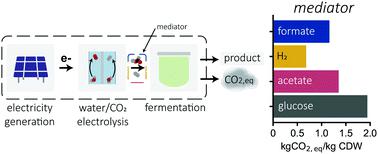当前位置:
X-MOL 学术
›
Energy Environ. Sci.
›
论文详情
Our official English website, www.x-mol.net, welcomes your
feedback! (Note: you will need to create a separate account there.)
A comparative life cycle analysis of electromicrobial production systems
Energy & Environmental Science ( IF 32.4 ) Pub Date : 2022-05-31 , DOI: 10.1039/d2ee00569g Anthony J. Abel 1 , Jeremy David Adams 1 , Douglas S. Clark 1, 2
Energy & Environmental Science ( IF 32.4 ) Pub Date : 2022-05-31 , DOI: 10.1039/d2ee00569g Anthony J. Abel 1 , Jeremy David Adams 1 , Douglas S. Clark 1, 2
Affiliation

|
Electromicrobial production (EMP) processes, in which electricity or electrochemically-derived mediator molecules serve as energy sources to drive biochemical processes, represent an attractive strategy for the conversion of CO2 into carbon-based products. However, these systems have yet to be employed on an industrial scale, limiting our understanding of their potential performance and environmental benefits/impacts. We describe the development and application of a comprehensive framework to analyze EMP systems relying on reactor, process, and life cycle impact models. This framework is used to analyze three proposed EMP systems relying on formate, H2, and acetate as intermediate molecules, each producing three hypothetical products: biomass, lactic acid, and industrial enzymes. Physics-based bioreactor models predict that EMP systems can achieve productivities up to 0.65 g L−1 h−1 for biomass production and 0.42 g L−1 h−1 for the production of lactic acid. Despite improved solubility of formate as a substrate, formate-fed EMP systems do not lead to improved productivities compared to H2-fed systems due to O2 gas–liquid mass transfer limitations (for biomass and enzymes) or salinity-induced toxicity issues (for lactic acid). Process models revealed that substrate generation was by far the largest energy demand of the EMP systems, followed by carbon capture and ammonia production, while energy required for gas–liquid mass transfer and fluid mixing accounted for only a small fraction of the systems’ energy footprints. Life cycle impact model results demonstrated that EMP systems can achieve a smaller carbon footprint than traditional bioprocessing strategies provided the electric grid supplying electricity to the EMP system is composed of at least 90% renewable energy sources. For each of the three products we consider, the H2-mediated Knallgas bacteria system achieves the lowest overall global warming potential, indicating that this EMP strategy may be best-suited for industrial efforts based on current technology. EMP systems also would use ∼95% less land compared to traditional bioprocesses. We also identify environmental hotspots and process limitations that are key targets for future engineering and research efforts for each EMP system. Our analysis demonstrates the utility of an integrated assessment framework and should help guide the design of working, scalable, and sustainable electromicrobial production systems.
中文翻译:

电微生物生产系统的比较生命周期分析
电微生物生产 (EMP) 过程,其中电或电化学衍生的介体分子作为能源来驱动生化过程,代表了将 CO 2转化为碳基产品的有吸引力的策略。然而,这些系统尚未在工业规模上使用,这限制了我们对其潜在性能和环境效益/影响的理解。我们描述了一个综合框架的开发和应用,以分析依赖于反应器、过程和生命周期影响模型的 EMP 系统。该框架用于分析三种依赖甲酸盐 H 2的 EMP 系统,和乙酸作为中间分子,每个产生三种假设产品:生物质、乳酸和工业酶。基于物理的生物反应器模型预测,EMP 系统可以实现高达 0.65 g L -1 h -1的生物质生产和 0.42 g L -1 h -1的乳酸生产。尽管甲酸盐作为底物的溶解度有所提高,但由于 O 2 ,与 H 2供料系统相比,供料甲酸盐的 EMP 系统不会提高生产率气液传质限制(对于生物质和酶)或盐度引起的毒性问题(对于乳酸)。过程模型显示,到目前为止,底物生成是 EMP 系统最大的能源需求,其次是碳捕获和氨生产,而气液传质和流体混合所需的能源仅占系统能源足迹的一小部分. 生命周期影响模型结果表明,如果向 EMP 系统供电的电网由至少 90% 的可再生能源组成,则 EMP 系统可以实现比传统生物处理策略更小的碳足迹。对于我们考虑的三种产品中的每一种,H 2介导的 Knallgas 细菌系统实现了最低的整体全球变暖潜能值,这表明这种 EMP 策略可能最适合基于当前技术的工业努力。与传统的生物工艺相比,EMP 系统还可以减少约 95% 的土地使用量。我们还确定了环境热点和工艺限制,它们是每个 EMP 系统未来工程和研究工作的关键目标。我们的分析证明了综合评估框架的实用性,并应有助于指导工作、可扩展和可持续的电微生物生产系统的设计。
更新日期:2022-05-31
中文翻译:

电微生物生产系统的比较生命周期分析
电微生物生产 (EMP) 过程,其中电或电化学衍生的介体分子作为能源来驱动生化过程,代表了将 CO 2转化为碳基产品的有吸引力的策略。然而,这些系统尚未在工业规模上使用,这限制了我们对其潜在性能和环境效益/影响的理解。我们描述了一个综合框架的开发和应用,以分析依赖于反应器、过程和生命周期影响模型的 EMP 系统。该框架用于分析三种依赖甲酸盐 H 2的 EMP 系统,和乙酸作为中间分子,每个产生三种假设产品:生物质、乳酸和工业酶。基于物理的生物反应器模型预测,EMP 系统可以实现高达 0.65 g L -1 h -1的生物质生产和 0.42 g L -1 h -1的乳酸生产。尽管甲酸盐作为底物的溶解度有所提高,但由于 O 2 ,与 H 2供料系统相比,供料甲酸盐的 EMP 系统不会提高生产率气液传质限制(对于生物质和酶)或盐度引起的毒性问题(对于乳酸)。过程模型显示,到目前为止,底物生成是 EMP 系统最大的能源需求,其次是碳捕获和氨生产,而气液传质和流体混合所需的能源仅占系统能源足迹的一小部分. 生命周期影响模型结果表明,如果向 EMP 系统供电的电网由至少 90% 的可再生能源组成,则 EMP 系统可以实现比传统生物处理策略更小的碳足迹。对于我们考虑的三种产品中的每一种,H 2介导的 Knallgas 细菌系统实现了最低的整体全球变暖潜能值,这表明这种 EMP 策略可能最适合基于当前技术的工业努力。与传统的生物工艺相比,EMP 系统还可以减少约 95% 的土地使用量。我们还确定了环境热点和工艺限制,它们是每个 EMP 系统未来工程和研究工作的关键目标。我们的分析证明了综合评估框架的实用性,并应有助于指导工作、可扩展和可持续的电微生物生产系统的设计。











































 京公网安备 11010802027423号
京公网安备 11010802027423号